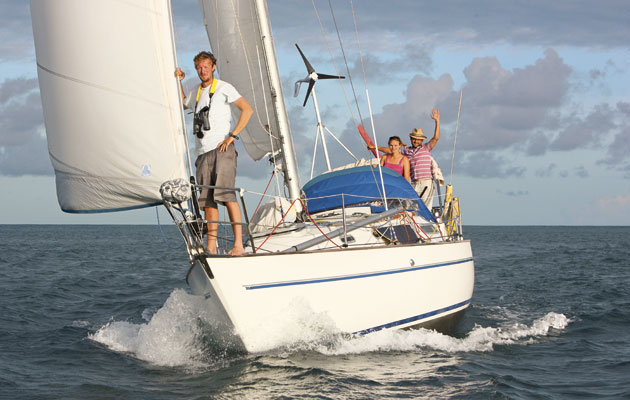John Parker, owner of the OneSails GBR (East) loft shares his top tips on sail trim to make the most of sailing in light airs
In all but the very lightest conditions, the overriding consideration for light airs sail trim is making adjustments that develop as much power from the sail plan, and to build and maintain hull speed, writes John Parker.
Even heavy boats, sailed well can build up good boat speed, and have more momentum to carry them through the lulls.
Minimal helm movements and judicious avoidance of waves or powerboat wash will help keep the way on.
1. Tell-tales
These most basic of sail trim aids remain absolutely essential, though many sails lack them.
Tell-tales should be fitted to the luff of a headsail and the leech of a mainsail.

Paying attention to tell-tails is a key sail trim tool to get efficient airflow over the sails. Credit: Graham Snook/Yachting Monthly
Without them, you are flying blind.
Buy some stick on ones if you don’t have them.
2. Backstay
Minimal backstay tension is required as this ensures that the mast has as little bend in it as possible, and the forestay will also have minimum forestay tension.

Releasing the backstay tension to straighten the mast and increase sail camber will help you sail in a breeze
This gives both main and headsail their greatest depth of camber to generate maximum power, though watch that the main’s leech doesn’t close as a result.
3. Vang
In light airs the vang has little to do in terms of holding the boom down, and the weight of the boom may be enough to over-tighten the main’s leech.

A rod kicker will take the boom’s weight in a light breeze
A solid strut vang will help support the weight of the boom, or you can use a little topping lift to do the same thing.
4. Halyard tension
Failing to ease halyard tension in light airs is a common error.
If a sail’s halyard is not eased as wind speed decreases the inbuilt camber will be too far forward, reducing the boat’s ability to point and overly opening the sails leech.
Continues below…
How to sail your boat in a summer breeze
Some boats are better in breezes than others, but a better understanding of your boat can keep you sailing for…
Bowsprit power for downwind sailing
Bowsprits are all the fashion on new boats these days, but do you need one? Graham Snook looks at how…
How to anchor under sail
Can you set and weigh anchor under sail, without turning the ignition key? Tom Cunliffe demonstrates a handy cruising skill
How to sail an Atlantic circuit
Sam and Alexandra Fortescue share the knowledge and experience they gained on a one-year Atlantic circuit from the UK to…
A simple rule of thumb is to ease a sail’s halyard until horizontal wrinkles appear on the luff, then tension the halyard until these wrinkles ‘disappear’.
In very light winds you can retain some of these wrinkles.
A Dyneema halyard will help you make precise adjustments.
5. Sheet tension
It might seem obvious, but in light airs less sheet tension is required.
When beating, the boat will be sailing at a greater apparent wind angle than in more windy conditions when boat speed becomes more important than pointing, with sails that are trimmed with relatively less sheet tension.
The headsail fairlead should also be moved forward to induce more camber in the lower portion of the sail and increase leech tension which likewise increases camber toward the head of the sail, all in all giving the headsail a more powerful shape.
6. Mainsheet traveller
By using a combination of traveller position and sheet tension, when beating, position the boom on the boat’s centre-line and maintain a leech twist profile that keeps the top batten tell-tales steaming for about 50% of the time.
In smooth water we can sail with less leech twist and perhaps the top batten tell-tale will only be visible for 30% of the time.
Conversely in rougher water we need more leech twist, and the top batten tell-tale should be visible for around 70% of the time.
7. Mainsail Outhaul
Outhaul tension impacts on mainsail shape from the foot of the sail up to around the height of the lowest leech batten.
While an eased outhaul gives a fuller shape, slowly moving air cannot adhere to a very curved surface.
Limit the depth of camber along the boom to no more than around 10% of the sail’s foot length.
Enjoyed reading Sail trim in light airs: 7 tips to keep you sailing?
A subscription to Yachting Monthly magazine costs around 40% less than the cover price.
Print and digital editions are available through Magazines Direct – where you can also find the latest deals.
YM is packed with information to help you get the most from your time on the water.
- Take your seamanship to the next level with tips, advice and skills from our experts
- Impartial in-depth reviews of the latest yachts and equipment
- Cruising guides to help you reach those dream destinations
Follow us on Facebook, Twitter and Instagram.








